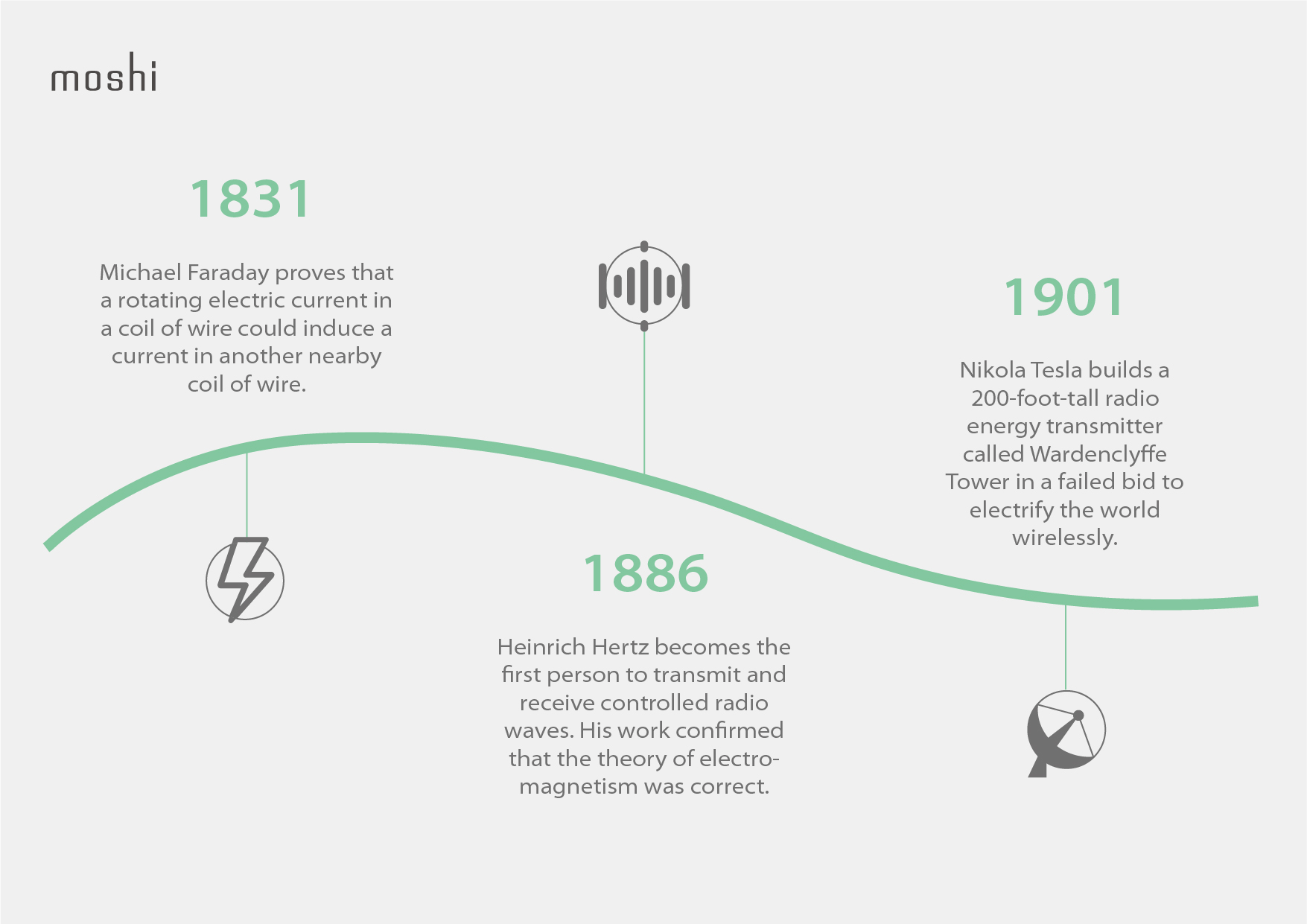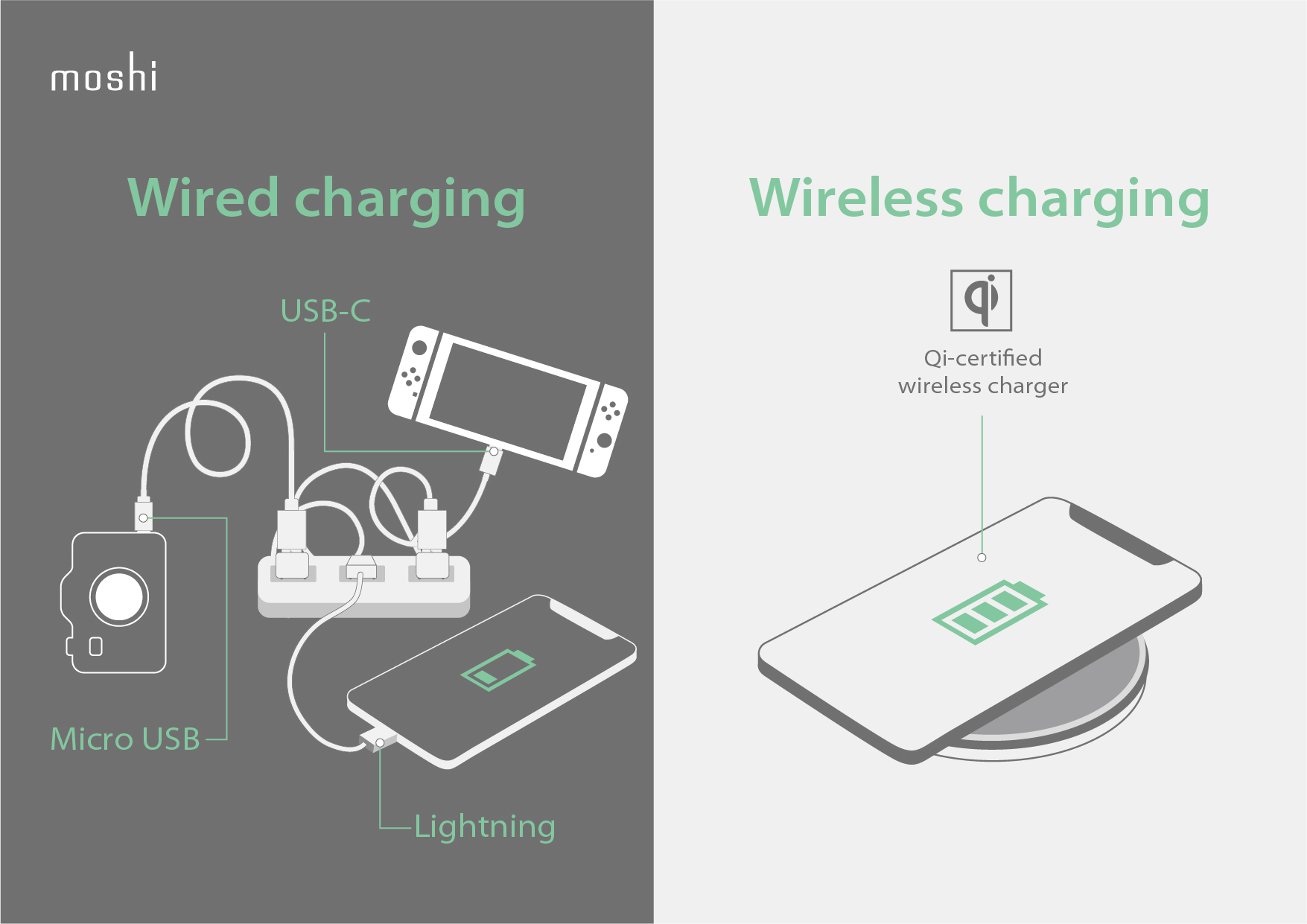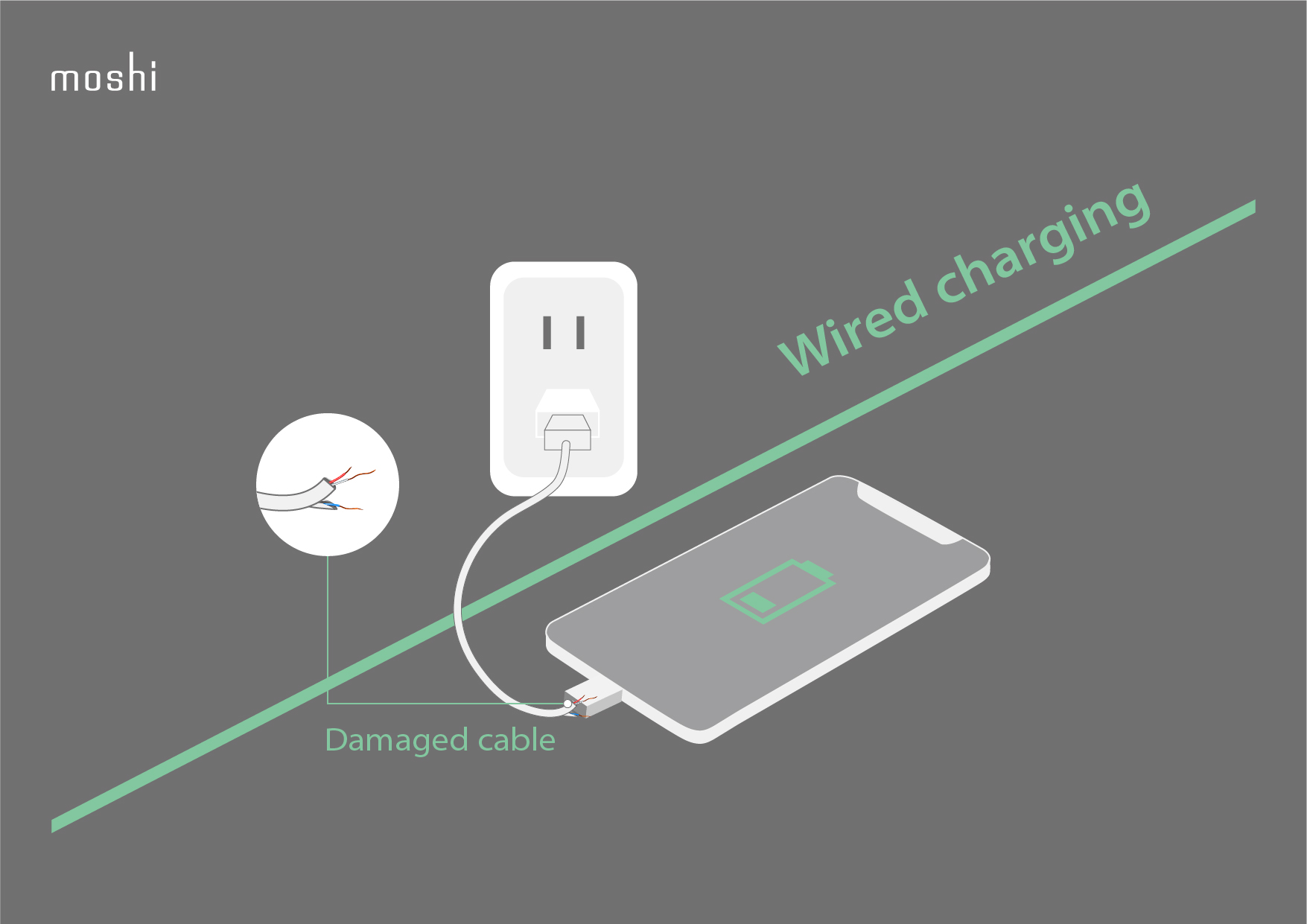The Ultimate Guide to Wireless Charging
When wireless charging first hit mainstream devices around 2012, the media hype was huge. Tech writers promised readers they'd be able to throw out their collections of mismatched cables and adapters. To charge, you'd plop your phone on a table, bowl, or desk as you walked by—like magic.
Although there were still a few kinks to work out, wireless charging technology continued to advance. Today, it's safe to say that convenient and efficient wireless charging has arrived—and it just keeps getting better.
Was the initial hype surrounding the technology warranted? As more consumers discover the ease and simplicity of wireless charging, it looks like the answer is yes.
History of wireless inductive charging
The desire to go wireless isn't new. People have been trying to transmit power without wires as long as there have been practical applications for it.
Here's a brief timeline of the early years of wireless power transmission:

Despite this progress, significant barriers to efficient wireless transmission remained. With few practical applications to be found, the technology crawled forward over the next 100 years. But the mobile device boom at the beginning of the 21st Century created a big incentive for researchers to revisit wireless charging.
This massive new market for wireless charging spurred progress, but it also created conflict—and headaches for consumers. For several years starting in 2006, different wireless charging standards competed for dominance.
These included the Powermat standard (adopted by heavy hitters like General Motors, Starbucks, and Delta Airlines) and the Wireless Power Consortium's (WPC's) Qi standard (first backed by tech powerhouses like Samsung, Google, and Verizon).
During this period, wireless charging fell short of its promise to make mobile devices easier to use. Most smartphone brands supported only one wireless charging standard (with the notable exception of Samsung). This often left consumers unable to use wireless charging stations without an adaptive case for their device.
By 2018, the Qi standard had won out. Apple's iPhone 8 family was the first generation of Apple phones to support wireless charging, and the rest is history. Powermat's entry into the WPC and the widespread adoption of the Qi standard ended the wireless charging wars.
Finally, wireless charging became practical thanks to everyone following a single standard.
Today, almost every wireless charger uses Qi, and most mobile devices support Qi wireless charging. The glass backs found on many new smartphones reflect the enormous demand for wireless charging (metal backs interfere with charging efficiency).
In the future, we can expect wireless charging to move well beyond smartphones. Before long, laptops, kitchen appliances, and even electric cars may all be capable of wireless charging.
"Today, almost every wireless charger uses Qi, and most mobile devices support Qi wireless charging."
How does wireless charging work?
Wireless charging works off the principle of electromagnetic induction. It's the same principle behind those induction stoves that have been around for years.
Both the charger and the receiving device contain wireless charging coils. The transmitting coil is located in the charging pad. The receiving coil is situated at the back of the phone and connected to the battery.
The transmitting coil converts electricity and emits an alternating electromagnetic field. When the receiving coil is within this field, it turns the energy into an electric current that is sent to the battery.

The evolution of Qi
The Qi standard (pronounced "chee") is named after the Chinese concept of the flow of vital energy through every living thing.
Set by the WPC, the Qi standard defines various power specifications that correspond to how much energy flows between charger and device. Qi also includes a data transfer spec which lets the device request the optimal amount of power from the wireless charger.

The Baseline Power Profile (BPP) specification supports up to 5 W of power output. The Extended Power Profile (EPP) specification supports up to 15 W. Both BPP and EPP are used to charge mobile devices, but EPP is more advanced thanks to its fast-charging support. For a more in-depth explainer, check out our blog article.
The Qi standard also includes a Medium power spec that currently delivers 30-65 W (it's expected to eventually support up to 200 W). This spec is used for larger devices like kitchen appliances, robotic vacuum cleaners, power tools, and drones.

Fast-charging with Qi
The difference between BPP and EPP may seem technical, but it has a significant impact on your wireless charging experience. All wireless charging products for mobile devices use either BPP (5 W maximum) or EPP (15 W maximum), and you might think that since EPP chargers can output more power, buying an EPP charger will automatically lead to faster charging. But that's not necessarily the case.
Your mobile device's ability to receive power is the limiting factor when it comes to charging speed. Your device must be able to receive 7 W of power to be capable of fast wireless charging, no matter what kind of charger you use.
Your phone's ability to receive power output is predetermined by the manufacturer. Here are the specs for a few major brands:
- Apple: 7.5 W
- Sony: 11 W
- LG: 10 W
- Google: 12 W*
- Samsung: 9 W**
*12 W charging for Pixel 5 devices
** Samsung requires that wireless chargers pass the additional Samsung Proprietary Power Delivery Extension (PPDE) certification in order to deliver power above 5 W. EPP chargers not certified under this extension will only charge at BPP wattage when used with Samsung phones. Read more about Samsung phones which support Qi wireless charging.
"Your device must be able to receive 7 W of power to be capable of fast wireless charging, no matter what kind of charger you use."
Even if your phone and charger both support fast wireless charging, choosing the wrong accessories can still slow you down. Both your cable and wall adapter must be able to receive enough power to be capable of fast charging. For example, if you own a 10 W charging pad plugged into a 5 W wall charger, your device will only charge at 5 W so you won't get the benefits of fast charging.
Make sure your device, cable, and wall charger all support enough power to enable fast wireless charging. Here's an example of a setup that will work:
- USB-C Wall Charger (10 W)
- USB-C to USB-C cable
- Charging pad (10 W)
What are the key advantages of wireless charging?
Less clutter
The main benefit of wireless charging is right there in the name—wireless. Wireless charging cuts down on clutter from charging cables. The only cable you'll need is the charging pad's power cable.

Easier charging
Wireless charging also eliminates the need to plug a cable into your phone. Ever plugged your phone in and discovered hours later that the cable connection wasn't secure—and your phone is still dead? Wireless charging eliminates that problem. Just place your phone on your charging pad, and it'll start charging right away.
Longer device life
No repeated cable plugging and pulling means less wear and tear on your phone's charging port. Since the charging port is a common point of failure for mobile devices, your phone may even last longer.
No cable compatibility issues
No charging cables also means you can say goodbye to that timeless problem among tech enthusiasts—mismatched connectors. No need to worry about not having a Lightning, USB-C, or Micro USB cable on hand anymore. All Qi devices work on all Qi charging pads.
Less e-waste
The benefits of reducing e-clutter go far beyond your personal tidiness. The current lack of a common wired charging standard leads to an enormous amount of unnecessary e-waste. The widespread adoption of wireless charging could help solve this problem.
Currently, most Android devices use USB-C ports, while Apple devices use the Lightning connector exclusively. That means that to switch from Android to Apple or vice versa, you need to get new charging cables (and maybe new adapters). Unfortunately, your old cables and adapters are very likely to end up in a landfill.
Charging cables may be small, but the e-waste problem isn't.

In January 2020, the European Parliament voted for new regulations to establish a universal charging standard for phone manufacturers in the European Union. The EU claims that agreeing on a shared charger standard will put an end to charger clutter and 50 million metric tonnes of e-waste annually (16.6 kg per inhabitant).
Wireless charging is ahead of the game when it comes to reducing e-waste. Qi wireless charging has already achieved a universal charging standard. Apple, Android, and Google all support the Qi standard, making it the most reliable charging standard today.
Safer charging products
As more users adopt wireless charging, additional benefits of standardized chargers will become clear. The quality of charging products on the market should go up, with fewer counterfeit chargers being sold. That will guarantee a higher level of safety for users worldwide.
6 myths about wireless charging
Despite its advancements, there are still many people with concerns about wireless charging. Most of these worries are holdovers from the old days of wireless charging when the standards weren't quite as refined.
Here are some of the most common myths and misconceptions busted.
1. Wireless charging is slow
This misconception may date back to wireless charging's 5 W days. It definitely was slow back then. But today's fast wireless charging pads can provide 10 or even 15 W of power, which is as fast or even faster than wired charging.
2. Wireless charging is inefficient
The conversion from electric current to electromagnetic field and back doesn't cause significant efficiency losses. You can recover as much as 80% of the input wattage when charging wirelessly, but make sure your wireless charger features an efficient coil design. Cheap uncertified wireless chargers tend to use inferior materials and components which can affect efficiency.
3. Wireless charging is dangerous
Some people think the energy transmitted wirelessly could be hazardous to your body. However, magnetic induction only works across very short distances. At a distance of only 4 cm, you're totally safe from any potential effects of the radiation, and charging pads do not emit electromagnetic radiation constantly. Qi-certified chargers won't produce a magnetic charging field unless a phone is on the pad.

4. Wireless charging can overheat your phone's battery
All charging (both wired and wireless) generates some heat, but solid electrical engineering can keep heat levels low enough to prevent battery damage. That's why it's essential to buy wireless chargers from a reputable brand. Learn why Moshi’s Q-coil technology keeps your device cool and was rated “the fastest wireless charger” in the world.

5. Frequent wireless charging degrades your phone's battery life
Charging in general doesn’t have an impact on battery life, and wireless charging may actually be safer than certain fast-charging cables. Qi wireless chargers use a lower current compared to wired charging, which creates a more stable charging scenario. Wireless chargers also make it easy to top off your battery throughout the day. By setting your phone on a nearby charging pad when not in use, you can prevent the battery from dropping below 50%, which may increase the overall lifespan of your battery.


6. Overnight wireless charging can damage your phone
For many people, overnight is the most convenient time to charge. However, some worry that charging while you sleep can lead to overcharging and potential battery damage. Luckily, this isn't something we need to be concerned about. Smartphone batteries have a charge control system that disconnects the battery from the charger as soon as the battery is 100% charged. No matter how long the phone sits on the charger, it stays at the cut-off of the charging current with no risk of overcharging. That applies to both wireless and wired charging.
The future of wireless charging
Wireless charging has a bold, bright future ahead of it. More and more manufacturers are including Qi support in their phones, and peripheral manufacturers are adding Qi charging to more devices.
Wirelessly charging your smartphone will probably get even easier as charging technology advances. Manufacturers like Google and Samsung now support reverse wireless charging on some models, which allows phones to wirelessly charge other phones and smaller devices such as earbuds.
The charging pad itself could be getting a makeover. Some devices like monitors and mouse pads now include integrated wireless charging. New accessories like Moshi’s SnapTo Series feature wireless charging built directly into the mount. Even furniture makers are getting in on the action by creating Qi-enabled tables and desks. That's precisely the kind of innovation that got people so excited about wireless charging when it first hit the scene.
Wondering when larger devices will cut the cord? It's already happening.
In June 2017, Dell launched the world's first laptop that can charge wirelessly using magnetic resonance charging technology. You can expect to see more manufacturers rolling out wireless charging-enabled laptops over the next few years.
Tired of trying to find counter space near an outlet for your Instant Pot, rice cooker, or food processor? Soon you won't need to. The WPC's upcoming Ki Cordless Kitchen standard will deliver up to 2200 W to kitchen appliances wirelessly.

When it comes to wireless charging, the future has finally arrived. There's never been a better time to adopt this promising technology.
Learn more: Q-coil Technology
Moshi’s Q-coil wireless charging module features a multilayer heat sink design for enhanced passive cooling. Unlike cheap wireless chargers made with entry-level components, Q-coil chargers stay cool even while fast-charging.

These are some of the high-quality components and materials that make this possible:
- Our charging coil module uses high-purity copper wire and a high quality ferrite sheet to improve charging efficiency and reduce temperature.
- Low-resistance DC/DC power converters improve conversion efficiency and regulate the circuit board's temperature.
- A special multilayer heat sink dissipates the charger's thermal energy downwards, reducing heat transfer between the charger and the phone.
- Built-in over-voltage, over-current, and over-temperature protection circuits make the charging process safer.
- Qi certification ensures charging compatibility, reliability and safety.
Learn more about the Qi wireless charging specification with our handy guide to Qi EPP, or check out our Q Collection Qi-certified wireless chargers.
Sample Block Quote
Praesent vestibulum congue tellus at fringilla. Curabitur vitae semper sem, eu convallis est. Cras felis nunc commodo loremous convallis vitae interdum non nisl. Maecenas ac est sit amet augue pharetra convallis nec danos.
Sample Paragraph Text
Praesent vestibulum congue tellus at fringilla. Curabitur vitae semper sem, eu convallis est. Cras felis nunc commodo eu convallis vitae interdum non nisl. Maecenas ac est sit amet augue pharetra convallis nec danos dui.
Cras suscipit quam et turpis eleifend vitae malesuada magna congue. Damus id ullamcorper neque. Sed vitae mi a mi pretium aliquet ac sed elitos. Pellentesque nulla eros accumsan quis justo at tincidunt lobortis denimes loremous. Suspendisse vestibulum lectus in lectus volutpat, ut dapibus purus pulvinar. Vestibulum sit amet auctor ipsum.










даркнет открыт
В последнее время даркнет, вызывает все больше интереса и становится объектом различных дискуссий. Многие считают его темным уголком, где процветают преступные деяния и незаконные действия. Однако, мало кто осведомлен о том, что даркнет не является закрытым пространством, и вход в него возможен для любого пользователя.
В отличие от открытого интернета, даркнет не допускается для поисковиков и обычных браузеров. Для того чтобы получить к нему доступ, необходимо использовать специализированные приложения, такие как Tor или I2P, которые обеспечивают анонимность и шифрование данных. Однако, это не означает, что даркнет закрыт от общественности.
Действительно, даркнет доступен каждому, кто имеет желание и возможность его исследовать. В нем можно найти различные ресурсы, начиная от дискуссий, которые не приветствуются в обычных сетях, и заканчивая доступом к эксклюзивным рынкам и сервисам. Например, множество информационных сайтов и форумов на даркнете посвящены темам, которые считаются запретными в стандартных окружениях, таким как политика, вероисповедание или цифровые валюты.
Кроме того, даркнет часто используется активистами и журналистами, которые ищут способы обхода цензуры и защиты своей анонимности. Он также служит средой для свободного обмена информацией и идеями, которые могут быть подавимы в странах с авторитарными режимами.
Важно понимать, что хотя даркнет предоставляет свободу доступа к информации и шанс анонимного общения, он также может быть использован для противоправных действий. Тем не менее, это не делает его закрытым и недоступным для всех.
Таким образом, даркнет – это не только скрытая сторона сети, но и место, где любой может найти что-то увлекательное или пригодное для себя. Важно помнить о его двойственности и разумно использовать его и осознанием возможных рисков.
Подпольная часть сети: запретная территория виртуальной сети
Темный интернет, скрытый уголок интернета продолжает вызывать интерес интерес как сообщества, так и служб безопасности. Этот подпольный слой интернета известен своей анонимностью и возможностью осуществления преступных деяний под маской анонимности.
Сущность подпольной части сети заключается в том, что этот слой не доступен для популярных браузеров. Для доступа к нему требуются специальные инструменты и программы, предоставляющие анонимность пользователям. Это создает отличную площадку для различных незаконных действий, среди которых торговлю наркотиками, торговлю огнестрельным оружием, кражу личных данных и другие незаконные манипуляции.
В свете растущую угрозу, некоторые государства ввели законодательные меры, направленные на запрещение доступа к темному интернету и преследование лиц осуществляющих незаконную деятельность в этой нелегальной области. Тем не менее, несмотря на предпринятые шаги, борьба с темным интернетом остается сложной задачей.
Следует отметить, что полное запрещение теневого уровня интернета практически невозможно. Даже с введением строгих мер контроля, доступ к этому уровню интернета все еще доступен с использованием разнообразных технических средств и инструментов, используемые для обхода блокировок.
Помимо законодательных мер, существуют также инициативы по сотрудничеству между правоохранительными органами и технологическими компаниями для борьбы с преступностью в темном интернете. Впрочем, для успешной борьбы требуется не только техническая сторона, но также улучшения методов выявления и предотвращения противозаконных манипуляций в данной среде.
В итоге, несмотря на введенные запреты и предпринятые усилия в борьбе с преступностью, подпольная часть сети остается серьезной проблемой, требующей комплексного подхода и совместных усилий со стороны правоохранительных структур, а также технологических организаций.
המימורים ברשת – הימורי ספורטיביים, קזינו אונליין, משחקים קלפים.
המימונים בפלטפורמת האינטרנט נהפכים לתחום פופולרי בבאופן מיוחד בעידן המחשב.
מיליוני שחקנים ממנסות את המזל באפשרויות הימורים המגוונים.
התהליכים הזה משנה את רגעי הניסיונות והתרגשות.
גם מעסיק בשאלות אתיות וחברתיות העומדים ממאחורי המימורים ברשת.
בתקופת המחשב, מימורים בפלטפורמת האינטרנט הם חלק בלתי נפרד מתרבות ה הספורט, הפנאי והבידור והחברה המודרנית.
המימונים בפלטפורמת האינטרנט כוללים אפשרויות רחבה של פעילויות, כולל הימורים על תוצאות ספורטיות, פוליטיות, ו- תוצאות מזג האוויר.
ההימורים הם הם מתבצעים באמצע
quos nam sit nisi ducimus nobis laboriosam aspernatur libero quis quia. explicabo laboriosam et nulla explicabo atque repudiandae occaecati eaque labore aut. est qui nulla molestias officiis rerum nos
Покупки в Даркнете: Иллюзии и Реальность
Даркнет, скрытая часть сети, манит интерес участников своей скрытностью и возможностью заказать самые разнообразные продукты и услуги без излишних действий. Однако, переход в этот вселенная скрытых рынков имеет в себе с набором опасностей и аспектов, о чём желательно знать перед осуществлением сделок.
Что такое темный интернет и как оно действует?
Для тех, кому не знакомо с этим понятием, скрытая часть веба – это сегмент веба, невидимая от обычных поисковых систем. В темном интернете существуют специальные рынки, где можно найти возможность практически все : от запрещённых веществ и боеприпасов и поддельных удостоверений и взломанных аккаунтов.
Заблуждения о заказах в темном интернете
Анонимность обеспечена: При всём том, применение методов скрытия личности, например Tor, может помочь скрыть от глаз свою активность в сети, анонимность в подпольной сети не является абсолютной. Существует опасность, что вашу личные данные могут обнаружить обманщики или даже сотрудники правоохранительных органов.
Все товары – качественные: В скрытой части веба можно найти множество продавцов, предоставляющих продукты и сервисы. Однако, нельзя обеспечить качество или подлинность товара, так как невозможно проверить до заказа.
Легальные сделки без ответственности: Многие участники неправильно думают, что заказывая товары в подпольной сети, они рискуют меньшему риску, чем в реальном мире. Однако, заказывая противоправные товары или сервисы, вы подвергаете себя риску наказания.
Реальность приобретений в скрытой части веба
Негативные стороны обмана и афер: В темном интернете многочисленные аферисты, готовы к обману пользователей, которые недостаточно бдительны. Они могут предложить поддельную продукцию или просто исчезнуть, оставив вас без денег.
Опасность государственных органов: Участники Даркнета подвергают себя риску к ответственности перед законом за заказ и приобретение неправомерных продуктов и услуг.
Непредсказуемость выходов: Не каждый заказ в подпольной сети заканчиваются удачно. Качество продукции может оставлять желать лучшего, а процесс покупки может привести к неприятным последствиям.
Советы для безопасных транзакций в скрытой части веба
Проводите детальный анализ поставщика и услуги перед совершением покупки.
Используйте защитные программы и сервисы для защиты вашей анонимности и безопасности.
Осуществляйте платежи только безопасными методами, например, криптовалютами, и избегайте предоставления личной информации.
Будьте предельно внимательны и осторожны во всех совершаемых действиях и выбранных вариантах.
Заключение
Сделки в темном интернете могут быть как захватывающим, так и опасным путешествием. Понимание рисков и принятие соответствующих мер предосторожности помогут снизить вероятность негативных последствий и обеспечить безопасность при совершении покупок в этом неизведанном мире интернета.